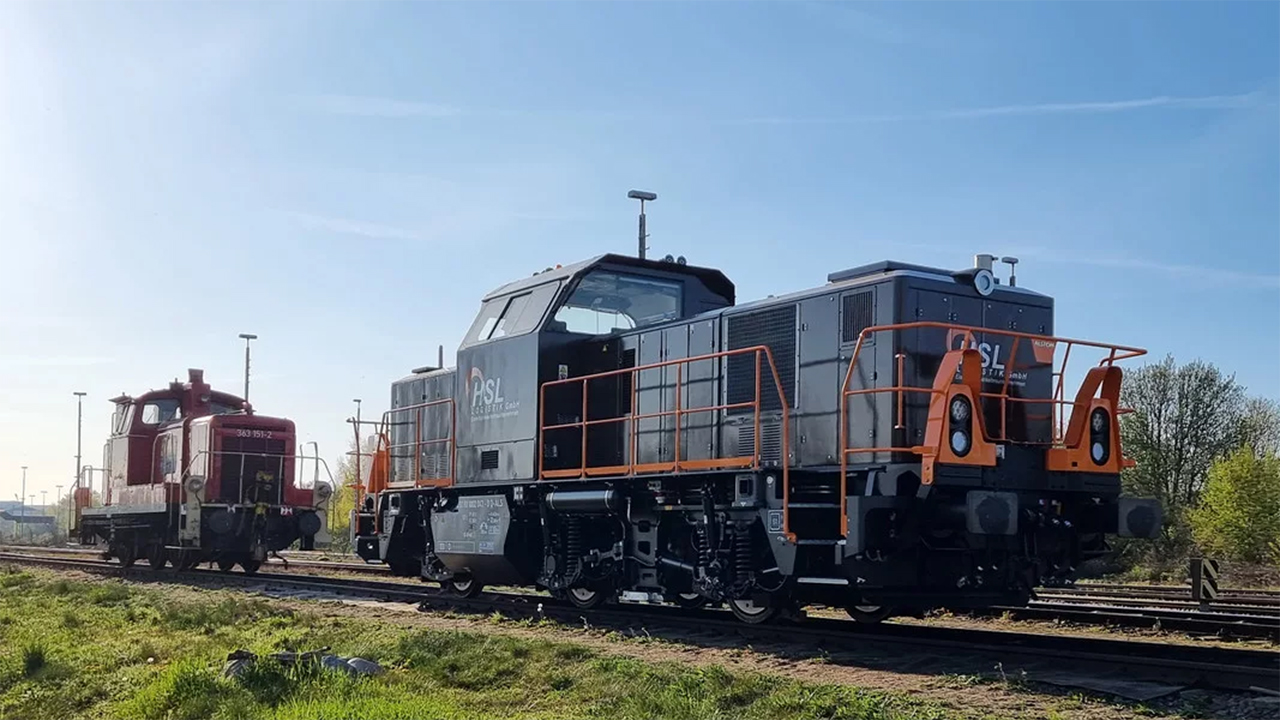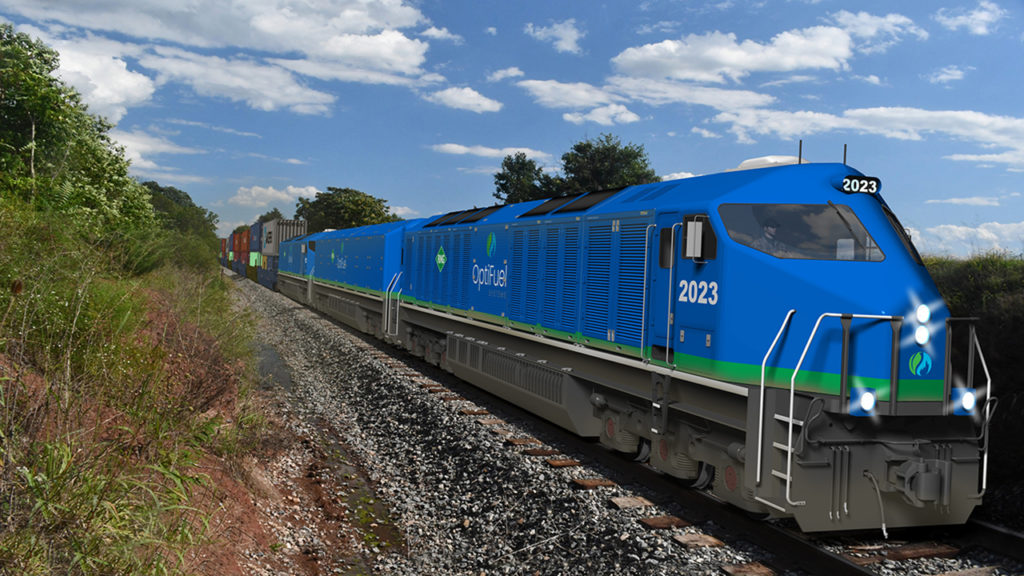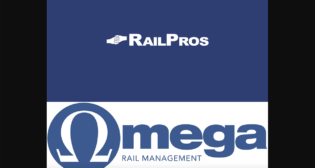
ZE Power for Short Lines
Written by Alex Luvishis, Ph.D
Alstom Prima H3 hybrid with HOPPECKE lithium-ion batteries.
Since the second half of the 20th century, four-axle diesel-electric switcher locomotives have been used extensively on short lines. The most common are the EMD SW1500 (1,500 hp/1,119 kW), GP9 (1,750 hp/1,305 kW) and GP38-2 (2,000 hp/1,491 kw), and the GE 44-ton (300 hp) and 70-ton (660 hp). More recently, older six-axle units have entered short line and switching service. The most common are the EMD SD40-2 and SD70, and the GE C36-7.
Short lines typically do not purchase new locomotives, and instead look to the secondary market. For a locomotive to be selected for operation on a short line, a large number would have been produced and successfully operated on Class I railroads for several years. As well, their cost should have decreased, and maintenance parts should still be available. The requirement of the Paris Climate Accord to prohibit locomotives that emit harmful substances after 2050 has worried the short line industry. 2050 may be many years away, but today only a few ZE (zero-emission) battery-electric (BE) switcher locomotives are in operation on Class I’s, and only one HFC (hydrogen fuel cell) switcher prototype is being tested on U.S. railroads.
It is unclear whether or when Class I’s will start using ZE locomotives on a large scale, though most experts are confident that this will happen by 2050. Short lines have been concerned that prices for ZE locomotives will not begin to decline until a few years after 2050 at best, and as such, fleet replacement with ZE units will be costly.
In California, railroads are deeply concerned about new regulations adopted by the California Air Resources Board (CARB) that will take effect April 27, 2024 to reduce pollutants from locomotives operating in the state. According to these rules, as of Jan. 1, 2030, diesel-electric locomotives permitted to operate in California must have an original engine build date of 2007 or newer and must meet Tier 4 requirements, or be BE, hybrid or genset. The U.S. EPA may contest this rule, basing its argument that railroads are federally regulated.
BE and Hybrid Power
OEMs Wabtec and Progress Rail as well as as others offer conversions to full BE and hybrid power. Below are examples of ZE switcher locomotives that have been produced or are being prepared for release:
- Wabtec FLXdrive™ BE: 96 tons, four-axle, 1,000 kW (1,340hp), 1,900 kWh, 370 kN starting tractive force. 189-ton six-axle locomotive, 3,100 kW (4,157 hp), 4,000 kWh, 1,900 kWh, 890 kN starting tractive force.
- Progress Rail EMD® Joule BE: GT387B, 107 tons, four-axle, 1,500 kW (2,040hp), 4,000 kWh, 388 kN starting tractive force. SD40JR, 160 tons, six-axle, 2,000 kW (2,682 hp), 4,000 kWh, 600 kN starting tractive force.
- Watco BE: 1,119 kW (1,500 hp) and 895 kw (1,200 hp), converted by India-based Medha.
- OmniTRAX subsidiary Newburgh & South Shore Railroad BE: former 1971-vintage GP9, 1,305 kW (1,750 hp) for service in Ohio).
- United States Steel Corporation BE: Two 1,119 kW (1500 hp) former SW 1500 converted by Innovative Rail Technologies (IRT) at Mon Valley Works Edgar Thomson and Clairton Plants. IRT has several other conversions under way with various clients.
- Tacoma Rail BE: Conversion of two 2,240 kW (3,000 hp) GP40M diesel-electrics.
- Alstom Prima H3 hybrid: To reduce weight, these switchers have been equipped with lithium-ion batteries by HOPPECKE sister company INTILION since 2019. Significantly improved performance and service life is achieved using the same amount of energy as nickel-cadmium, and the weight of the complete battery system was reduced to 1.5 tons. The Prima H3 can reach speeds of up to 100 km/h in battery mode and is the first hybrid switcher locomotive to be approved for use by DB in Germany and SNN in Switzerland.
Hydrogen and RNG
Along with battery locomotives, short lines can use converted locomotives that use low-carbon fuel such as RNG (renewable natural gas) and hydrogen as diesel fuel substitutes, or HFC (hydrogen fuel cell) hybrids in which electricity produced by the fuel cell charges the batteries. Following are several examples:
Sierra Northern (SERA) will use a $15.6 million grant from the California State Transportation Authority (CalSTA) to convert three diesel switchers to HFC (hydrogen fuel cell) powered ZE units. According to CARB, the per-unit conversion drive cost is $109,500.
Deutz and Cummins have developed low-power hydrogen engines that replace existing diesel power plants, as well as retrofit kits that allow hydrogen to be substituted for diesel. In addition to the engine changes, the diesel fuel tank is removed from the locomotive and replaced with hydrogen storage and distribution equipment.
In 2024, trial operation of Alstom’s 390 kW (523 hp) H3 hybrid switcher locomotive with a Deutz TCD 12 direct-injection hydrogen ICE (internal combustion engine) is expected to begin.
In 2025, Irish Railways is expected to begin trial operation of a six-axle diesel-electric locomotive modernized by Digas (Riga, Latvia) to use hydrogen fuel. No. 071 is based on the EMD JT22CW. The engine is a 1,680 kW (2,250) EMD 12-645-3V.
OptiFuel Systems (U.S.) offers diesel locomotive conversions to its ZE system, which uses RNG, a bio-based synthetic natural gas (biogas) from which impurities have been removed. Based on the Cummins 1SX12N engine, the KOFSG11.9400 series six-cylinder, 11.9L engine produces 298 kW (400 hp). The engine has been used in switcher locomotives on the Indiana Harbor Belt (IHB). When the engine is running on petroleum-based natural gas, NOx emissions are small, but not zero. When the engine is running on a combination of petroleum-based and renewable gases, NOx and PM are zero, as confirmed by IHB switcher locomotive tests. (OptiFuel Systems will be showcasing its OptiFuel Total-Zero™ Locomotive at the 2024 ASLRRA Annual Conference & Exhibition in Kansas City, March 24 to 26. The linehaul locomotive is described as “the industry’s first modular, customizable, ZE (zero-emission) locomotive. Customers can select from RNG (renewable natural gas), hydrogen, or BE (battery-electric) power modules, with RNG delivering an unmatched combination of price and performance advantages.”)

In June 2022, OptiFuel Systems entered into an agreement with Argentina Railways to convert 400 switcher and main line locomotives to its ZE system. The company intends to use its new 500kW (670 hp) engines using RNG and subsequently hydrogen as fuel. For a switcher locomotive with a capacity of 1,500kW (2,012 hp), three diesel generator (genset) units will be used. Assemblies with gas cylinders are placed on and under the carbody frame. For a 1,500 kW locomotive, 18 RNG cylinders (1,480 DGE, diesel gallon equivalents) or 337 kg of hydrogen are used. The locomotive is a hybrid. Along with diesel generators, lithium-ion batteries with energy of 600 kWh are placed on board At the ACT Expo in May 2023, Cummins demonstrated its new hydrogen internal combustion engine (H2-ICE) X15H with up to 372 kW (500 hp). After Cummins begins production of this engine series, OptiFuel Systems can install its own system, allowing use of hydrogen fuel.
The Outlook
Within the next few years on U.S. railroads, BE switcher locomotives will most likely outnumber other ZE switchers. However, let’s not be too optimistic and close our eyes to the fact no BE switcher on U.S. railroads has yet accumulated sufficient experience in reliable operation. But we will assume that the technical problems of operating BE switcher locomotives on short lines can be solved.
Short lines are more concerned about the costs associated with BE locomotives rather than technical problems. According to the Institute for Rolling Stock Concepts, part of the German Aerospace Center (DLR), modernization of a 4-axle switcher locomotive in Germany:
- With installation of a hydrogen-burning diesel engine costs US$1.6 million.
- With conversion into a hybrid locomotive with hydrogen fuel cells, US$2.3 million.
- With conversion into a BE, US$2.6 million dollars.
These costs are approximate. In addition, prices for U.S. locomotives may differ from those shown. I provide these figures to show how differences in technologies affect costs. It seems that the pattern characteristic of German locomotives will be true for the U.S. The least expensive modernized locomotives those with hydrogen-burning diesel engines. Hybrid locomotives with fuel cells are significantly more expensive; BE locomotives are the most expensive. It appears that, based on these costs, U.S. short lines today are not ready to operate even small batches of switcher locomotives with hydrogen engines or switcher hybrid locomotives with fuel cells. Prototypes of such locomotives must first be thoroughly tested. However, by 2050, such locomotives could compete with BE units.
According to CARB, a typical 1,490 kW (2,000 hp) BE switcher consumes 3,200 kWh of energy in 16 hours of operation. In order for the battery to retain 20% charge when discharged, the energy of the installed battery must be 4,000 kWh. Considering that, according to December 2022 information from BloombergNEF, the average price of a lithium-ion battery pack is US$151/kWh. Thus, the battery cost alone of the above-mentioned Progress Rail EMD® Joule GT387B is US$604,000, and the battery cost of the Wabtec FLXdrive™ switcher is US$286,900. It should be noted that when converting an existing locomotive to BE, it is possible not only to install a battery, but also to change the traction drive by using either an IAC axial control system or an AC drive. When using a new drive, the traction properties of the locomotive at low speeds will improve, necessary for a switcher locomotive.
The coming 10-15 years may be difficult, intense, stressful years for short lines, regarding motive power. When overcoming difficulties, you must always remember that the goal is a healthier life for people all over the world.

Alex Luvishis, Ph.D. for 18 years headed the laboratory that developed control systems for Russia’s first electric locomotives and asynchronous traction motors in the former USSR. For a further seven years, he headed the rolling stock department at the Institute of Technical Information of Railway Transport in Moscow. Dr. Luvishis is the author of more than 100 articles on electric traction drives and the book “Hybrid Rail Vehicles,” published in 2009. His interests are asynchronous traction drive systems for modern rolling stock, and hybrid drive systems for trams, suburban and regional trains and switching and main line locomotives. He has lived in the U.S. since 1999.



